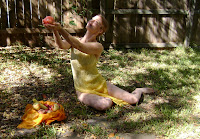 |
| Duncan's bouncy run with a red Roma apple! |
Upon sauntering in to the Newflower Farmers Market on the corner of William Cannon and Manchaca the other day, I was struck by the plump yams, the fat squashes and the plentiful varieties of apples overflowing the baskets and bins in the produce section. Not to mention the giant pumpkins just ripe for jack-o-lantern carving. The combination of cool winds beckoning sweaters and scarves and the hearty fruits and vegetables begging to be baked or stewed and served warm brings to mind two fruit-inspired myths important to the Duncan dance tradition.
The two stories—Atalanta (and the golden apples) and Persephone (and the pomegranate seeds)—model characteristics of woman in a variety of aspects. Atalanta is strong, willful, independent, and unwilling to marry. She challenges potential suitors to a race in which victory for the suitor is rewarded by marriage but Atalanta’s victory equals the suitor’s death. Pretty high stakes for the suitor—does that mean that Atalanta equates marriage with death?
Of course, in the second story—that of Persephone—there is no doubt that marriage equals death, for the maiden Persephone is kidnapped by Hades and taken to the Underworld to be his bride. Yet her sorrow and reticence coupled with her mother’s outrage over her fate (and a few ingested pomegranate seeds) result in a compromise allowing Persephone to return to the earth’s surface for several months of the year. These myths are complex and offer room for interpretation from many different perspectives—exactly what makes them so interesting to explore through dance movement!
 |
| Offering a pomegranate to the autumn sun! |
These myths also highlight the seasonal aspect of women’s lives—from maiden to reproductive maturity to crone—as well as the earth’s rhythm of planting, growing, harvesting, and decay. While some might find the perennial philosophy that undergirds Duncan’s early modern dance practice to be a tad on the romantic side, during this time of shifting seasons and with festivities abounding from Halloween to All Saints Day to Day of the Dead, I personally enjoy contemplating how the themes of these myths resonate with contemporary life experience. For instance, how do you find the balance between fighting for what you believe in and letting go, in acceptance of circumstances beyond your control? Perhaps the lesson is in contemplation rather than in answering the question. And what better way to contemplate than through the dance?
Stay tuned for next week’s reminiscence on another ancient myth—but this time from the Celtic tradition! Austinites, if you happen to be in Houston next weekend, check out Selkie, a Sea Tale, a contemporary opera I am collaborating on with Divergence Vocal Theater for Friday and Saturday evening shows at Obsidian Arts Space in Houston—and Houstonites, come see the show!